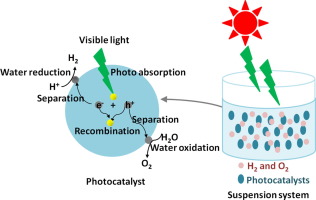当前位置:
X-MOL 学术
›
Mater. Today
›
论文详情
Our official English website, www.x-mol.net, welcomes your feedback! (Note: you will need to create a separate account there.)
Recent advances in visible light-driven water oxidation and reduction in suspension systems
Materials Today ( IF 24.2 ) Pub Date : 2018-10-01 , DOI: 10.1016/j.mattod.2018.04.009 Dan Kong , Yun Zheng , Marcin Kobielusz , Yiou Wang , Zhiming Bai , Wojciech Macyk , Xinchen Wang , Junwang Tang
Materials Today ( IF 24.2 ) Pub Date : 2018-10-01 , DOI: 10.1016/j.mattod.2018.04.009 Dan Kong , Yun Zheng , Marcin Kobielusz , Yiou Wang , Zhiming Bai , Wojciech Macyk , Xinchen Wang , Junwang Tang

|
Abstract In order to solve the shortage of sustainable energy and the related concern about combustion of fossil fuels, converting the most abundant solar energy into chemical fuels becomes one of the most promising choices to provide the everlasting and environmentally friendly energy vector along with the minimum impact on environment. Among the methods of converting solar energy into chemical fuels, there is a significant interest in the renewable hydrogen production by photocatalysts from abundant water under visible light irradiation. Therefore, the development of efficient photocatalysts for water reduction and oxidation in a suspension system is the footstone for the development of solar energy conversion. In this review, the fundamental theory of photocatalysis and key factors affecting photocatalysis will be introduced first. Then the new materials development covering inorganic materials (oxides, nitrides and sulfides), carbon-based photocatalysts, and semiconductor-coordination compound photocatalysts developed over the past 10 years will be addressed with discussion about dominating factors in the photochemical process. This review would provide a comprehensive reference to exploring the efficient and novel materials working for the solar energy conversion to affordable and sustainable fuels. Finally, the perspective of the technology is also discussed.
中文翻译:

悬浮系统中可见光驱动水氧化和还原的最新进展
摘要 为了解决可持续能源的短缺和化石燃料燃烧的相关问题,将最丰富的太阳能转化为化学燃料成为最有前途的选择之一,以提供持久、环保的能源载体,同时将影响最小化。关于环境。在将太阳能转化为化学燃料的方法中,在可见光照射下,通过光催化剂从丰富的水中生产可再生氢引起了人们极大的兴趣。因此,在悬浮体系中开发用于水还原和氧化的高效光催化剂是太阳能转换发展的基石。在这篇综述中,将首先介绍光催化的基本理论和影响光催化的关键因素。然后将讨论过去10年开发的无机材料(氧化物、氮化物和硫化物)、碳基光催化剂和半导体配位化合物光催化剂的新材料开发,并讨论光化学过程中的主导因素。该综述将为探索用于将太阳能转化为负担得起的可持续燃料的高效新型材料提供全面参考。最后,还讨论了技术的前景。该综述将为探索用于将太阳能转化为负担得起的可持续燃料的高效新型材料提供全面参考。最后,还讨论了技术的前景。该综述将为探索用于将太阳能转化为负担得起的可持续燃料的高效新型材料提供全面参考。最后,还讨论了技术的前景。
更新日期:2018-10-01
中文翻译:

悬浮系统中可见光驱动水氧化和还原的最新进展
摘要 为了解决可持续能源的短缺和化石燃料燃烧的相关问题,将最丰富的太阳能转化为化学燃料成为最有前途的选择之一,以提供持久、环保的能源载体,同时将影响最小化。关于环境。在将太阳能转化为化学燃料的方法中,在可见光照射下,通过光催化剂从丰富的水中生产可再生氢引起了人们极大的兴趣。因此,在悬浮体系中开发用于水还原和氧化的高效光催化剂是太阳能转换发展的基石。在这篇综述中,将首先介绍光催化的基本理论和影响光催化的关键因素。然后将讨论过去10年开发的无机材料(氧化物、氮化物和硫化物)、碳基光催化剂和半导体配位化合物光催化剂的新材料开发,并讨论光化学过程中的主导因素。该综述将为探索用于将太阳能转化为负担得起的可持续燃料的高效新型材料提供全面参考。最后,还讨论了技术的前景。该综述将为探索用于将太阳能转化为负担得起的可持续燃料的高效新型材料提供全面参考。最后,还讨论了技术的前景。该综述将为探索用于将太阳能转化为负担得起的可持续燃料的高效新型材料提供全面参考。最后,还讨论了技术的前景。



























 京公网安备 11010802027423号
京公网安备 11010802027423号